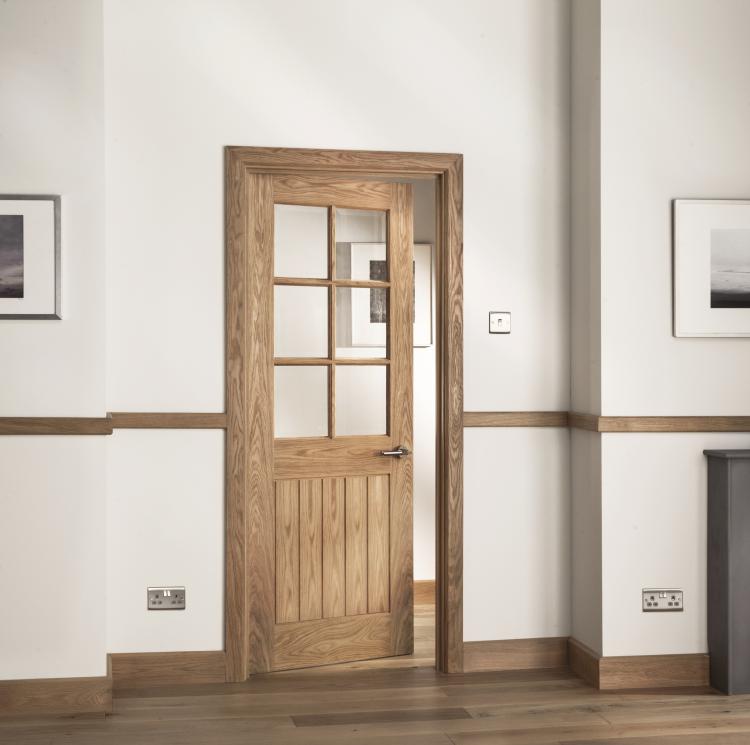
Hello and welcome to our four-part help guide series that will take you through the steps on how to hang an interior door, how to trim an interior door if it is too big, how to fix door furniture, and how to finish a door. Whatever your background – from an experienced tradesperson to a weekend DIY’er – hopefully, you will come out the other side with some great tips and best practices that you can take away with you and apply to your interior development projects.
Please visit Blueprint Cottage Doors for more information on the Internal Doors that we stock.
The first article in the fortnightly series is a step by step guide on how to hang an interior door; both in a new frame and existing frame. Fitting a new door can be a very tricky, hands-on task. We recommend that this should be undertaken by someone that is experienced and confident in home renovation/someone that loves a DIY challenge. If you are unsure after reading this article, please always get a local joiner or tradesperson involved as mistakes can be very costly. We also recommend referring to your product fitting instructions at all times of the installation process. All our fitting guides can be found here on the website.
How to measure for a replacement interior door
If you are looking to replace an existing door, but it is still a good fit, you can measure that. It is important that you obtain a height, width, and thickness of the existing door and then find a door that is closest to your measurements; making sure to round up, not down. The table below shows the door measurements that we stock currently on the website for our Engineered Oak Interior Door range:
| Normal Oak Interior Door Sizes | Fire Door Oak Interior Door Sizes (FD30) |
| 1981 x 610 x 35mm | 1981 x 762 x 44mm |
| 1981 x 686 x 35mm | 1981 x 838 x 44mm |
| 1981 x 762 x 35mm | |
| 1981 x 838 x 35mm |
So, for example, if your existing door measures 1975mm (high) x 760mm (wide) x 35mm (thick), you would require a door size 1981mm x 762mm x 35mm.
If you have a new frame but with no interior door, you will need to measure the height, width, and thickness of the inside opening of the frame. We recommended that you measure the height at three different points (left, middle and right), and width at three different points (top, middle, and bottom). Use the largest of both height and width sizes to determine what size door you will need, then like above, round up the measurements to the nearest standard door size from the table above.
Recommended equipment
Below is a list of tools and equipment useful in hanging an interior door:
- A tape measure
- Pencil
- Combination square (an instrument that provides both metric and imperial graduations and level to make your work easy and accurate)
- Wood chisel
- Rubber mallet
- Plane power tool
- Sandpaper
- Drill
- Drill bits designed specifically for wood
- Door wedge (to assist in holding the door in place while hanging)
- Safety equipment including face mask and safety goggles.
An important consideration before hanging an interior door
A big mistake people make when hanging a new internal door is adding door furniture (such as a handle or latch) first before cutting the door to fit the frame. Especially when it comes to an existing frame in an older house, the first thing to warp due to structural movement is the door frame. If this is the case and you find that you need to adapt the existing door frame, we always recommend building out the frame, so it is square before cutting the doors to suit. Ideally, you are looking for a gap of no more than 2mm around the door when fitted. With the door and door opening perfectly to size and fit, this means you can more accurately and easily install hinges, handles, and latches afterwards.
Which way up and which way around?
Sounds silly I know, but hanging an interior door upside down does happen. With your door in front of you unwrapped and ready to be hung, there is usually a lock or key symbol which indicates what side you will need to fit the handle and latch. If you are unable to locate a symbol or piece of wording, you can check by tapping the door with the end of a screwdriver or your hand; the side the furniture will need to be fitted to will sound solid due to the lock block, while the opposite side will emit a more hollow sound when knocked.
If in doubt, always check product fitting instructions and lifestyle images for more information specific to your door.

1 - Remove the old door
Unscrew the old interior door. It is always best practice to take out the screws from the bottom hinge before the top hinge. Use the door wedge to help assist you with supporting the door while you take the last screw out.
2 - Trim the new door to size
Hold the new interior door in the door frame to see if it needs any adjustment. As mentioned earlier on in this guide, you are looking for a gap of no more than 2mm around the door when fitted. The gap at the bottom of the door might be slightly larger depending on the type of flooring you have. If your existing door was a good fit, you can use that as a template and mark down the areas of the new door you need to trim.
With the new door ready to be resized, plane the door using an electric plane and sand for a smooth finish. It is important that you trim an equal amount of wood from both the top and bottom of the door to keep it in balance. Always be cautious with the amount of wood you trim off in one go. It is a best practice that you keep going back to the door frame to see how close you are to the fit. It is very easy to remove too much wood, but impossible to reverse those changes if you have trimmed too much off.
More information on trimming (or
An important safety tip: It is important to wear a face mask and safety goggles while using an electric plane to protect your face and eyes from dust and small wood particles.
3 - Mark hinge positions
With the door trimmed to size, it is now ready to have the hinge positions marked out on both the door frame and door. There are a variety of different hinges on the market, but for the most part, you will probably be dealing with a standard butt hinge.
Unless your fitting instructions state otherwise, there is no rule as to where to position the hinges as such. If you are using an old door frame, tidying up the old hinge sections usually works out fine. If the new hinges do not fit where the old hinges were situated, rest the new hinges on the bottom of the existing hinge recess and mark along the top of the new hinge. Cut out the excess wood with a chisel and mallet. If you need to fill old hinge recesses, you can either use filler or cut a piece of timber to fit the hole (also known as scarfing).
If you have a new door frame, we recommend that you position the top section of the top hinge 7 inches from the top of the door, and the bottom section of the bottom hinge 7 inches from the bottom. These measurements might change depending on the situation or your preference.
Mark the position of the new hinges with a pencil. Drill small pilot holes to reduce the chance of the wood splitting. Fix the new hinges in position on the door frame.
Position the new door against the door frame at its final fixed height; use the door wedge to support the door if required. Mark the hinge positions and then cut the appropriate recesses in the door edge to accommodate the hinges. Again, just like with the door frame, drill small pilot holes before inserting the screws. Now you are ready to hang the door in position.
4 – Hang your new interior door
With the hinges fixed to the door frame, all that is required is to fasten the new door to the fixed hinges. Position the new door against the door frame and ensure the door is at the correct height; using a door wedge for stability will help with this part. Fix the hinges into place temporarily with a single screw. Check the door closes flush, and the gap between the door edges and frame are around 2mm (might be slightly different at the bottom depending on the type of flooring you have). When you are satisfied with the fitted door, the remainder of the screws can be screwed in to hold the hinges in place.
With your new interior door fitted perfectly into place, you are now ready to fix handles, latches and then finish your door if you wish to. You can find the next step by step guide here where we take a look at how to fit door
Common questions
We have recently changed how the door swings in our living room due to a rearrange. Ever since the change, the door now sticks and scrapes on the floor. How can we resolve this issue?
It sounds like you might need to plane or sand the door. We can assume the door is only slightly out at the bottom, so instead of taking the door off its hinges, use a piece of sandpaper (on top of a thin plank of wood or cardboard), place it under the open door, and then open and close the door until the problem is solved.
One of our interior doors swings open on its own; how do you stop this?
Remove a hinge pin from the bottom of the door, bend it a little and reinstall. Bending the hinge pin should stop the door from swinging open on its own.
I have recently had a new carpet fitted with thick underlay. As a result, to close the door takes some force. I am reluctant to trim the doors as they are really old. Is there anything else I can do?
There are two solutions: 1) Remove the thick underlay in that section, or 2) Use rising butt hinges rather than normal butt hinges to give you that extra floor clearance.
